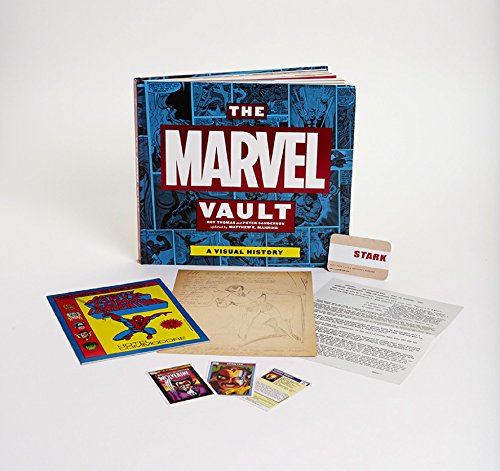Originally published in 2007, Roy Thomas and Peter Sanderson’s The Marvel Vault was clearly in need of Matthew K. Manning’s 2016 update. There’s no clear delineation identified when the first edition ended and the new one begins, but somewhere around the “One More Day”/ “Brand New Day” reboot of Spider-Man is as close as I can pin down.
Although the book tells “the history of Marvel Comics (or Timely, as it was in initially called), from 1939 to present,” it was a classy touch to give credit to crosstown rivals National Allied Publications’ (before they became DC Comics) Action Comics #1 starring Superman for “start[ing] the super hero revolution in comics.” Soon after, pulp-magazine publisher Martin Goodman was pitched the idea of publishing comic books on behalf of Lloyd Jacquet’s Funnies, Inc, leading to Marvel Comics #1, and the rest is history as revealed in this book.
The chapters are broken into decades, running from the 1940s to 2010s, with many images included in telling the company’s visual history. Alongside the text, there are comic covers, comic pages, archival photos, promotional material, and more. Many Marvel fans will surely recognize the characters Sub-Mariner, the Human Torch, and Ka-zar from the early days, but it’s even more interesting to see the mustachioed, wingless character named the Angel taking on the armless Tiger Man.
The company didn’t solely focus on superheros and the Vault shows Timely’s forays into stories about funny animals after Dell Publishing had success with comics starring Disney characters, into teenagers after the success of Archie, and into Westerns. Moving through the ’50, there were horror comics and the horror that was the impact of a psychiatrist who doesn’t deserve to be named.
The 1960s saw a landmark change with the company and the industry when Stan Lee, with the artistic talents of Jack Kirby, created the Fantastic Four, which wasn’t “just aimed at youngsters,” but offered “something new under the comic book sun: super heroes far more fallible, more realistic, more human than readers had experienced in the medium’s first two or three decades.” With the Marvel Age born, the Vault showcases the comic-book beginnings of familiar heroes who some readers may have first learned about at the movies, such as Hulk, Spider-Man, and The Avengers.
The decades roll along, and with them, new characters and new creators are introduced. As well as new problems, as seen during the 1990s when fans had to deal with eight versions of of Todd McFarlane’s Spider-Man #1; the “Clone Saga,” which revealed that about two decades of stories didn’t star the original Peter Parker; and the company’s Chapter 11 bankruptcy. But that was two decades ago and Marvel is still flourishing.

The book comes with memorabilia reproductions housed in an envelope affixed inside the front cover that has such a small opening it is sure to tear after repeated uses. I am nervous every time I try to get out the items. They are a Sub-Mariner sketch (credited to likely being by Carl Pfeufer), Stan’s story outline for Fantastic Four #1, a Marvel Convention program from 1975, three trading cards from a set created in 1990, and a Stark business card for Lucy Park from Human Resources.
The Marvel Vault makes for a fascinating trip down memory lane for those curious about what went on behind the pages. It’s highly recommended.